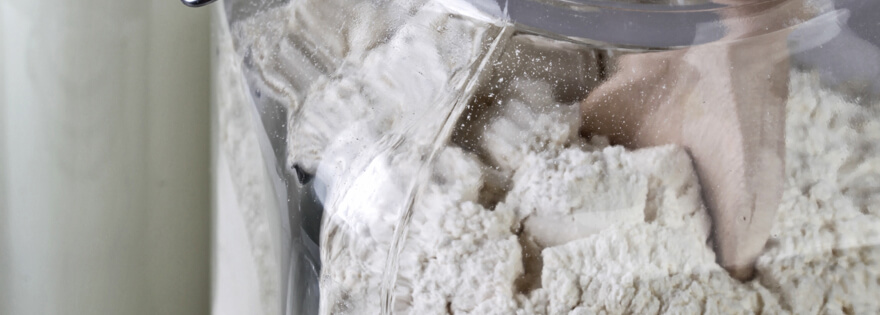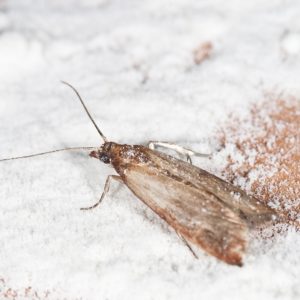What Causes Pantry Moths & What to Do When You Find Them
By: EarthKind
Have you ever noticed weird clumps in an old bag of flour or even a new one you just got from the grocery store? Ever noticed webbing along the corners or edges of food packaging or rice that appears to be moving? If the answer is no, you’ve luckily managed to avoid this unsettling experience. If the answer is yes, you’ve seen pantry moths.
Understanding more about these unpleasant pests can help with removing them from your home, as well as preventing them in the future. Find out what causes pantry moths, where they come from, and the life cycle stages they go through.
What Are They?
The term ‘pantry moth’ usually refers to the Indian meal moth, also commonly referred to as a ‘flour moth’. The name “Indian meal moth” came from an entomologist who observed their larvae infesting cornmeal, which was commonly called “Indian meal” in the 1800’s. The two other names came about due to the location these pests are commonly found inside of a home.
While there are numerous different types of these pests, the Indian meal moth is the most common household pantry pest in the United States. It is different from other types because it is attracted to stored, typically dry foods, unlike the clothes moth which is attracted to clothing and fabric, or other agricultural pest types. Homeowners sometimes notice the infested foods due to webbing on packaging, clumping within flour or they can see the larvae moving around. But typically, they won’t be noticed until the adult stage when they begin flying around.
Where Do Pantry Moths Come From?
These pests can enter your house in numerous different ways. They can make their way in through open doors and windows. They can enter through openings around dryer vents, plumbing lines, or cables that pass through walls. Another common way they get into your home is by stowing away inside of food packaging or contaminated food from a store or warehouse, like pet food for example. Once they’ve made their way into a food item, the problem will likely get bigger.
Pantry moths are on a mission. Their only objective is to reproduce and they infest places with an abundant food supply. This gives them a safe place to lay their eggs, giving their offspring the best chance of survival. They rely on their sense of smell to find a mate and a food source. Since you may not notice them until you see an adult moth flying around your home, it’s possible they have already laid their eggs somewhere inside.
Keep your home pest free with simple, effective solutions. Subscribe and save!
 The Pantry Moth Life Cycle
The Pantry Moth Life Cycle
There are four stages they will go through throughout their lifetime:
- Egg: Moth eggs are extremely small and a whitish grey in color. An adult female can lay approximately 400 eggs at a time, and they can hatch in just 7 days. As mentioned before, they typically lay eggs inside of food packages due to the abundant amount of food readily available.
- Larva: This is the stage that causes damage. Moth larvae are tiny worm-like eating machines. Their color can be affected by the food they are eating, and the frass (waste) and casings they leave behind will contaminate food, making it unusable. The larval stage typically lasts 2-3 months depending on conditions.
- Pupa: While in the pupal stage, they are in cocoons, usually hidden in cracks, corners, or crevices. Sometimes the cocoons are buried underneath food, causing the matted webs and clumps that may be found when cleaning after a moth infestation. They usually take 15-20 days to develop from pupae into adults.
- Adult: Adult moths appear as winged insects that are attracted to light and fly all around. The purpose of flying around is to find a mate so they can reproduce. They do not have working mouthparts and cannot eat, meaning their only objective is to reproduce. However, since the other stages of the moth life cycle are incredibly stealthy, you may not notice an infestation until this stage which can last one to two weeks.
When you add their life cycle stages together, pantry moths typically live around 3-4 months total.
Are They Harmful?
Pantry moths aren’t known for spreading disease, but they can contaminate food in the home kitchen or pantry. This can be unsettling to see and expensive to replace. In food processing facilities, their webbing can cause major damage to machinery.
If you notice these pests inside your home, it’s time to do a thorough check of your pantry items. Unfortunately, any items you see that are contaminated will need to be tossed. You’ll want to check items that were close as well and throw them away if you notice any signs of these creatures.
Placing all dry foods inside airtight containers before storing them in your pantry can help prevent this problem from occurring. It’s also a good idea to do a routine check of the food items in your pantry, even the new, sealed containers you may have just brought home.
Preventing household pests is easier than cleaning up after an infestation. If your home is already infested, then it’s important to be proactive with the issue and work quickly to remove the problem. Learn more about preventing and getting rid of pantry moths naturally here and consider using Stay Away® Moths, a fast-acting, botanical repellent that you place in the problem area to help.







 The Pantry Moth Life Cycle
The Pantry Moth Life Cycle

 day
day